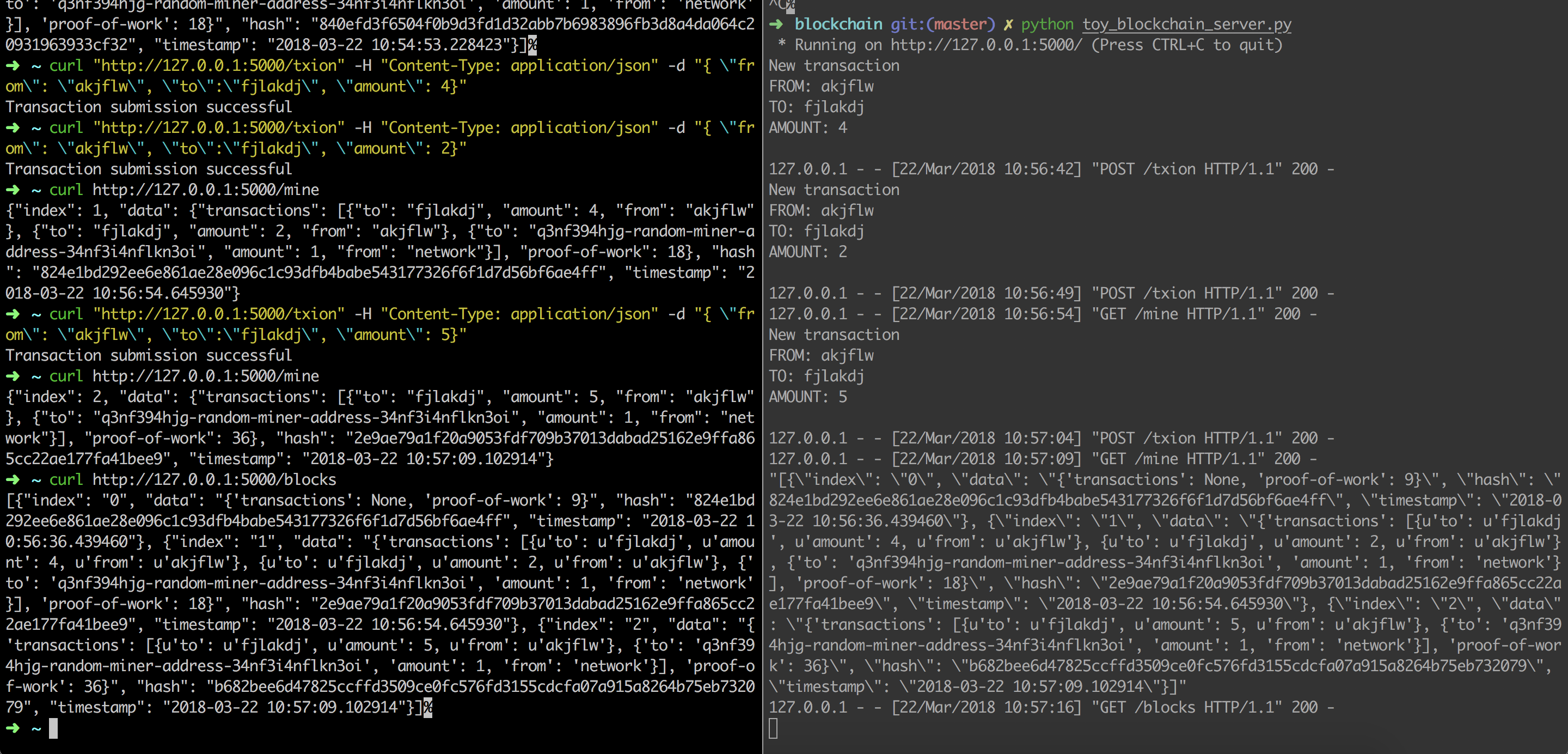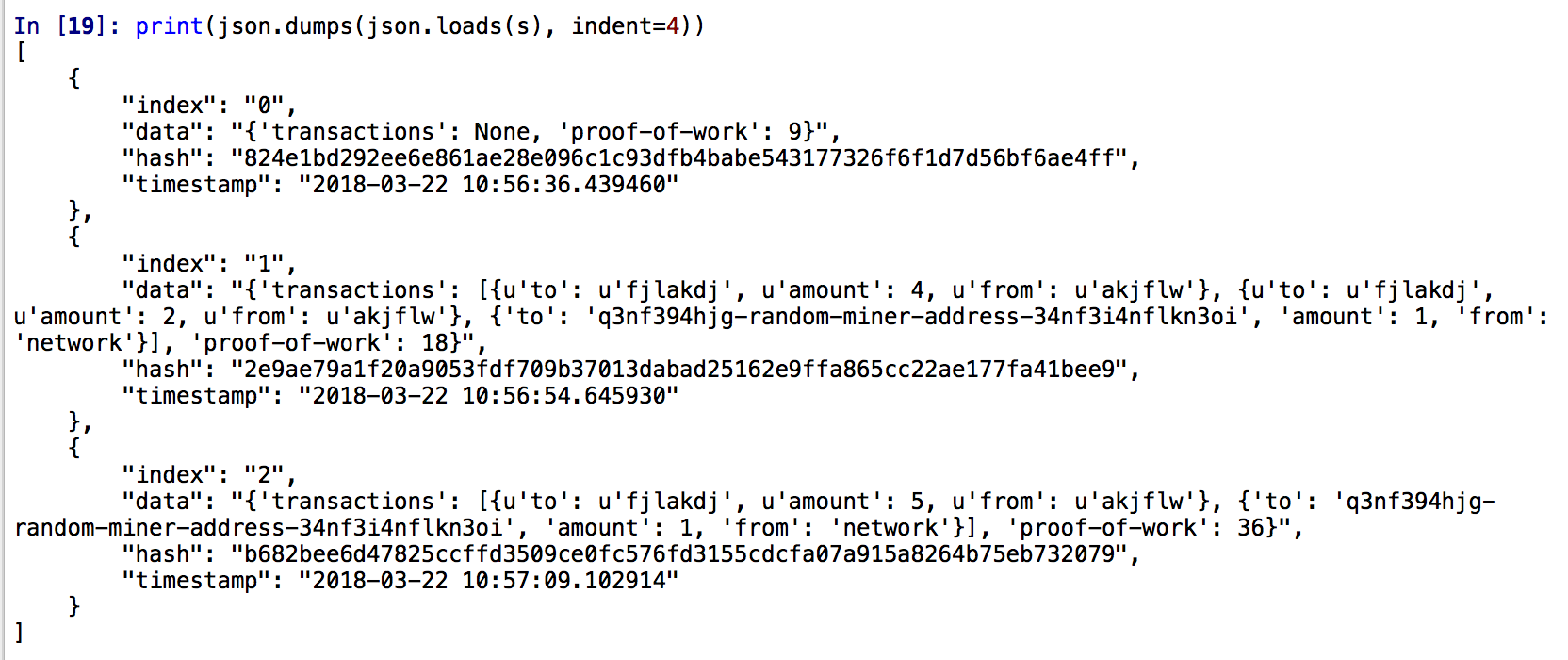Get Started Reference
https://medium.com/crypto-currently/lets-build-the-tiniest-blockchain-e70965a248b https://mp.weixin.qq.com/s/GrpY52N5VDWB7UOqmIadUg
- an immutable chain
- are not issued or managed by central authority (去中心化)
- distributed computing
Definiation of BlockChain
a digital ledger in which transactions made in bitcoin or another cryptocurrency are recorded chronologically and publicly.
Running the BlockChain Flask Server with the Sample Code
https://github.com/qd452/QuoinexMathMaX/blob/master/blockchain/toy_blockchain_server.py
Basically, the process is
- Create Transactions (lists of transactions in one block)
- Miners will come and start to mine this transactions, Proof of Work (POW) will be used to limit the speed and prevent the inflation
- After the mining process is done, this block will be appended into the block chain, during which, the miners will also be awarded with certain amount of coins in the case of Bitcoin
- repeat the above procedures


SHA-256
Reference: https://www.movable-type.co.uk/scripts/sha256.html
- A cryptographic hash (sometimes called ‘digest’) is a kind of ‘signature’ for a text or a data file. SHA-256 generates an almost-unique 256-bit (32-byte) signature for a text.
- A hash is not ‘encryption’ – it cannot be decrypted back to the original text (it is a ‘one-way’ cryptographic function, and is a fixed size for any size of source text).
- Note that hash functions are not appropriate for storing encrypted passwords, as they are designed to be fast to compute, and hence would be candidates for brute-force attacks.
Usage of SHA-256 in Bitcoin
- Mining uses SHA-256 as the Proof of work algorithm.
- SHA-256 is used in the creation of bitcoin addresses to improve security and privacy.
SHA-256 pure-python Implementation
- https://stackoverflow.com/questions/7321694/sha-256-implementation-in-python
- https://bitbucket.org/pypy/pypy/src/tip/lib_pypy/_sha256.py?fileviewer=file-view-default
Interesting side-track
proof of work Birthday attack https://en.wikipedia.org/wiki/Birthday_problem Birthday problem very simple explanation: https://betterexplained.com/articles/understanding-the-birthday-paradox/ -> Explanation: Counting Pairs
[Side-track] Copy in Python - Shallow and Deep copy
The difference between shallow and deep copying is only relevant for compound objects, which are objects containing other objects, like lists or class instances.
- https://docs.python.org/2/library/copy.html
- Very Good example: https://stackoverflow.com/questions/2612802/how-to-clone-or-copy-a-list
- https://www.python-course.eu/deep_copy.php
[Side-track] UTF-8 an Encoding in Python 2 and Python 3
1
2
3
4
5
6
7
8
9
10
11
12
13
14
15
16
17
18
19
20
21
22
23
24
25
26
27
28
29
30
31
32
33
34
35
36
37
38
39
40
41
42
43
44
45
46
47
import sys
import hashlib
SHA_DIGESTSIZE = 64
SHA_BLOCKSIZE = 32
is_py2 = sys.version[0] == '2' # added py2&3 compatibility
sha = hashlib.sha256()
org_str = "hahaha"
if not is_py2:
org_str = org_str.encode(encoding='utf8')
sha.update(org_str)
assert sha.digest_size == 32
# In Python3, cannot have 64L
# In Python3, int and long in Py2 has been mapped to int in Python
assert sha.block_size == 64 # https://stackoverflow.com/questions/23741762/why-does-python-add-an-l-on-the-end-of-the-result-of-large-exponents
rslt = sha.digest()
hexrslt = sha.hexdigest()
if is_py2:
assert rslt == '\xbe\x17\x8c\x05C\xeb\x17\xf5\xf3\x040!\xc9\xe5\xfc\xf3\x02\x85\xe5W\xa4\xfc0\x9c\xce\x97\xff\x9c\xa6\x18)\x12'
else:
rslt_str = ''.join(r'\x%.2x' % x for x in rslt)
rslt_lst = [x for x in rslt]
assert rslt_lst[0] == 190
# convert the list back to bytes array
assert bytes(rslt_lst) == rslt
# Note: in utf-8, code point of rslt_lst[0] is 190
tmp = b'\xbe'
assert type(tmp) == bytes
assert len(tmp) == 1
assert tmp[0] == 190
assert tmp != '¾' # note here is NOT equal
assert tmp != 190 # bytes are not equivalent to its code point
assert chr(tmp[0]) == '¾'
assert len(rslt) == sha.digest_size
assert hexrslt == 'be178c0543eb17f5f3043021c9e5fcf30285e557a4fc309cce97ff9ca6182912'
if is_py2:
# NOTE: https://docs.python.org/2/library/functions.html#ord
_hexrslt = ''.join(['%.2x' % ord(i) for i in rslt])
else:
_hexrslt = ''.join('%.2x' % i for i in rslt)
# or
_hexrslt = ''.join('{:02x}'.format(i) for i in rslt)
assert hexrslt == _hexrslt